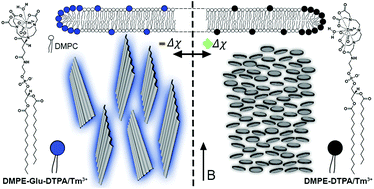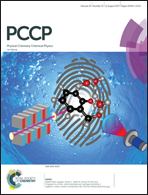Molecular engineering of lanthanide ion chelating phospholipids generating assemblies with a switched magnetic susceptibility†
Abstract
Lanthanide ion (Ln3+) chelating amphiphiles are powerful molecules for tailoring the magnetic response of polymolecular assemblies. Mixtures of 1,2-dimyristoyl-sn-glycero-3-phosphocholine (DMPC) and 1,2-dimyristoyl-sn-glycero-3-phospho-ethanolamine-diethylene triaminepentaacetate (DMPE-DTPA) complexed to Ln3+ deliver highly magnetically responsive bicelles. Their magnetic properties are readily tuned by changing the bicellar size or the magnetic susceptibility Δχ of the bilayer lipids. The former technique is intrinsically bound to the region of the phase diagram guarantying the formation of bicelles. Methods aiming towards manipulating the Δχ of the bilayer are comparatively more robust, flexible and lacking. Herein, we synthesized a new Ln3+ chelating phospholipid using glutamic acid as a backbone: DMPE-Glu-DTPA. The chelate polyhedron was specifically engineered to alter the Δχ, whilst remaining geometrically similar to DMPE-DTPA. Planar asymmetric assemblies hundreds of nanometers in size were achieved presenting unprecedented magnetic alignments. The DMPE-Glu-DTPA/Ln3+ complex switched the Δχ, achieving perpendicular alignment of assemblies containing Dy3+ and parallel alignment of those containing Tm3+. Moreover, samples with chelated Yb3+ were more alignable than the Tm3+ chelating counterparts. Such a possibility has never been demonstrated for planar Ln3+ chelating polymolecular assemblies. The physico-chemical properties of these novel assemblies were further studied by monitoring the alignment behavior at different temperatures and by including 16 mol% of cholesterol (Chol-OH) in the phospholipid bilayer. The DMPE-Glu-DTPA/Ln3+ complex and the resulting assemblies are promising candidates for applications in numerous fields including pharmaceutical technologies, structural characterization of membrane biomolecules by NMR spectroscopy, as contrasting agents for magnetic resonance imaging, and for the development of smart optical gels.



 Please wait while we load your content...
Please wait while we load your content...